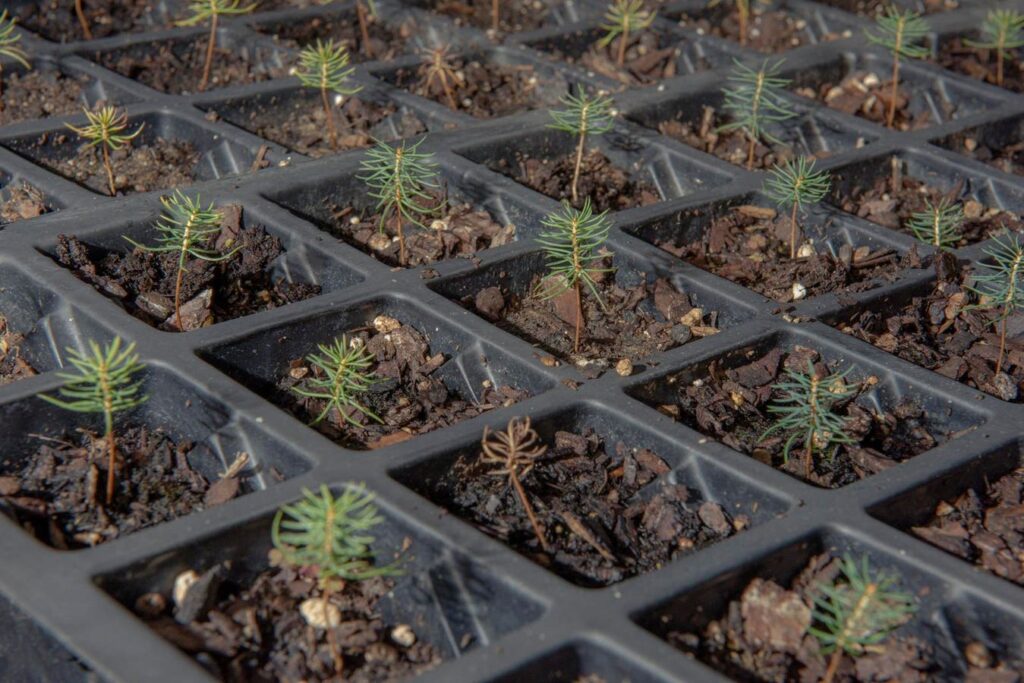To counter climate change, red spruce trees are grown inside a N.C. nursery in a federal effort with … [+]
The U.S. government is channeling nearly $1 billion in federal infrastructure investments into planting native seeds in a toolkit from nature to better protect people, ecosystems and commerce from extreme weather damage.
Through a myriad of programs under the U.S. Department of Interior’s Ecosystem Restoration and Resilience Framework, the National Seed Strategy is a focus area where millions of federal dollars are being spent on “strategic and evidence-based” environmental conservation and land restoration projects.
America’s native plants and associated wildlife habitats increasingly are being destroyed by invasive species, natural disasters and wildfires. It’s best when ground damaged under those scenarios can recover with natural seeds (adapted genetically over time and specific to certain areas) and be repopulated with native plants within their proper ecosystems. Area-specific natural seeds can’t really be bought in stores. They must be collected in advance and planted after disasters to prevent and preserve indigenous ecosystems from being overrun by different vegetation that destroys habitats and harms dependent wildlife.
In addition, soil without its native plants, lost through disasters, often becomes susceptible to erosion and flooding.
The federal government relies on its National Seed Strategy to create resilient habitats that also can work to counter weather-related disasters from getting worse and mitigate adverse ecological ripple effects due to dependencies that life forms have on one another.
To explain the concept of national ecosystems as a key piece of America’s infrastructure, the Interior Department issued a fact sheet about resiliency projects founded on nature that are being funded via the Restoration and Resilience Framework.
“Our ability to repair these damaged lands and stem the loss of cultural and economic benefits to society depends upon appropriate and sufficient seed resources for replanting and the associated research, decision tools, and public support for ecological restoration,” the document stated, in its seed section. Replanting natural seeds where native plants once grew is a way to fast-track the renewal of vegetation.
In the case of wildfires, U.S. government statistics underscore the need for greater resiliency and paint a grim picture about some of the known economic impacts related to wildfires.
Although putting a finger on the exact economic costs tied wildfire damage is difficult, Congress’ Joint Economic Committee last year estimated the annual cost of economic damages can range from $394 billion to $893 billion due to losses linked to evacuations, electricity costs, income, insurance payments, property damage, real estate values, smoke exposure and timber as well as damage to aquifers and watershed levels. Another related figure is a $2.9 billion annual price tag spent to suppress wildfires by the U.S. Department of Agriculture and Department of the Interior. That number, released in May, is expected to climb.
Comparing the last three decades of statistics about the number of acres burned yearly in wildfires is sobering. The figures are tracked by the Idaho-based National Interagency Fire Center. (NIFC is governed by such federal stakeholders as the U.S. Fire Administration, the Bureau of Indian Affairs, U.S. Fish and Wildlife Service, National Park Service, the U.S. Forest Service and National Weather Service. The center also has a liaison provided by the U.S. Department of Defense.)
From 1990 through 2019, U.S. wildfires burned 106% more acres (68.4 million) within 2010-2019 compared to a total of 33.2 million acres consumed by blazes in the 1990s. In other words, wildfire damage based on acreage size progressively increased, even jumping 84% to 61.2 million acres from 2000-2009 compared to the previous decade.
In February, the BLM announced $18 million in new federal investments in natural seeds to counter climate change through landscape resilience.
“Nature has spent thousands of years designing plants that fit in place, so we can’t do better than to use that instruction – native seed – in our restoration efforts,” said Tracy Stone-Manning, BLM director, in a press statement about the funding. “Native seeds stand a better chance of long-term success.”
The use of seeds to uplift nature and spread the U.S. government’s work to make national infrastructure stronger continues through many efforts and coordination among different federal branches. Though tiny, natural seeds have become strong links within the national strategy to increase overall resiliency in the plant supply chain and fight negative aspects of climate change.

